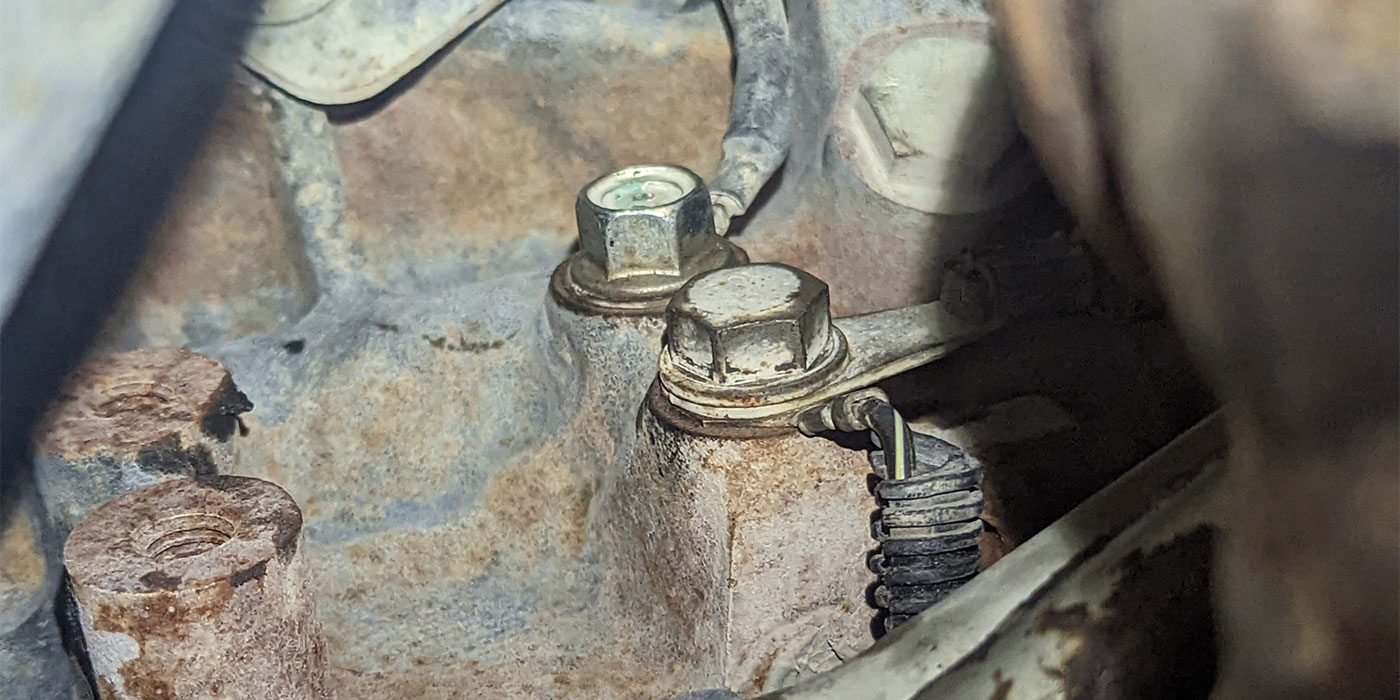
R&R Tech
- Subject: Code 1776 – solenoid-switch valve stuck in low/reverse position
- Vehicle Application: 2004 Dodge Intrepid
- Essential Reading: Diagnostician, R & R
- Author: Richard Middleton, Certified Transmission
When you install a replacement transmission and the car still has the same problem it came in for, it makes you think the problem is with the car, not the transmission. On the other hand, if you’re a shop that rebuilds “in house” and installs the same transmission that came from the car, you now face the dilemma of whether you misdiagnosed the problem or failed to resolve it in the rebuild process.
Here’s one of those stories that I hope will save you from having to experience this for yourself. This could have happened to anyone, but it happened to a shop that buys and installs our transmissions. Fortunately, we were able to bring the vehicle into our facility to help resolve the issue for the shop and its customer.
- Patient: 2004 Intrepid
- Symptom: Code 1776 – solenoid-switch valve (SSV) stuck in low/reverse position
The technician thoroughly test-drove the car but couldn’t get the code to recur. Because of the high mileage, and experience with this code, the shop ordered and installed a Certified remanufactured transmission. After installation and test drive the replacement transmission worked well, and the car was delivered to the customer on a Friday evening.
Monday morning, the patient was back. The customer described the same scenario. She said it acted up at the same spot on her trip to work as before the repair. In other words, “It’s doing the same thing.” Of course, it also had the same code.
To understand this code you need to know how the low-reverse/lockup (LR/LU) solenoid works in conjunction with the SSV to control both the LR and the torque-converter clutch (TCC). The main point to understand is that if the SSV sticks in the LR position, as the transmission control module (TCM) commands the TCC on it will apply the LR clutch, which will cause a bind-up.
Coming to a grinding halt from 40-60 mph would be no fun and would be a “slight” safety hazard. So, as a safety net, the TCM monitors the low-reverse pressure switch (LRPS). If the switch closes while the TCM commands TCC on, the computer assumes the SSV is stuck in LR position and stops trying to apply the TCC before the solenoid makes enough pressure to cause the bind-up. I suggest reviewing ATSG bulletin number 08-22 for more understanding of this.
Scoping the LRPS, compared with the LR/LU solenoid command, is the only way to really see what is going on, so that’s what I did. ATSG has a good article on this process in the red seminar handout for 2007.
Figures 1 and 2 show how the TCC apply looked when I installed the scope. In these diagrams, yellow is the ground side of the LR/LU solenoid, and the green trace is the LRPS. Figure 1 is with a larger time scale to show how frequently the glitches occurred. Figure 2 is with a smaller scale to show the glitches more clearly.
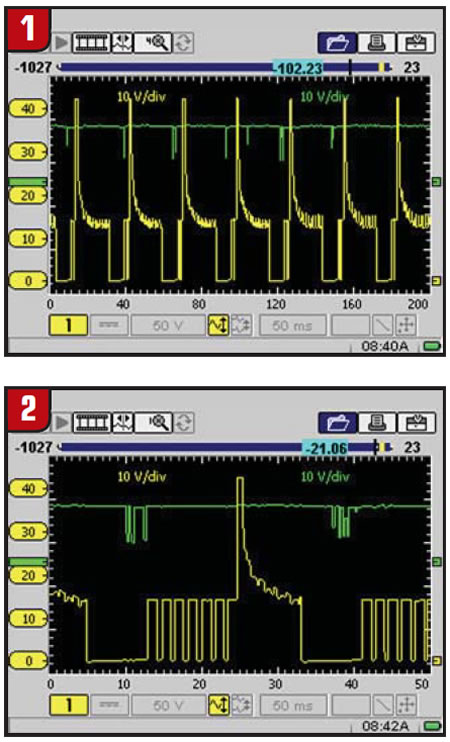
I saw the glitches and wondered about them. I was expecting to see something more along the lines of what a 2-1 downshift looked like, because if the SSV were completely stuck in the LR position, the TCC command would look just like a 2-1 downshift, except the computer would give up applying the TCC before a major bind-up occurred. Figure 3 shows what a 2-1 downshift looks like on the scope.
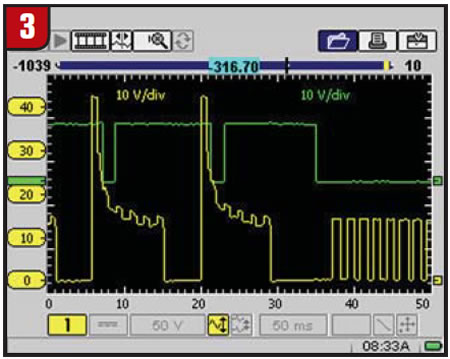
What I found to be particularly interesting was how “clean” the transition from high to low was. When I compared this with figures 1 and 2, I concluded that the SSV was not stuck completely in the low-reverse position.
This Intrepid has a “remote” battery. I removed the breather and the headlight to clean the battery terminals, and afterward the test drive showed a good pattern for TCC apply (Figure 4).
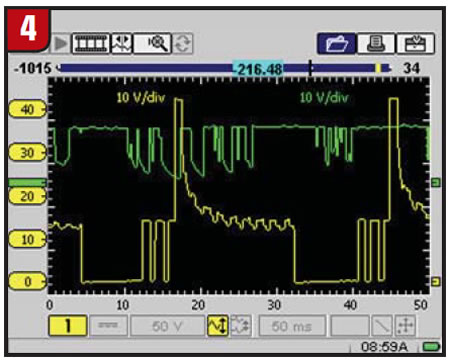
I thought it was fixed, but our patient came back the next day. I hooked up the scope and drove the car again and still could not get the code to recur. The pattern was glitchy again, so obviously it’s intermittent and thereby was fooling us into thinking the problem was fixed. The customer even took me for a ride and still the code wouldn’t recur. I was able to capture some more scope patterns of the TCC apply (figures 5 & 6).
Figure 5 shows many drops in voltage on the LRPS circuit as the TCC applies. I found it interesting how many drops happen in one cycle of pulses on the solenoid. There were still several glitches even after the computer stopped pulsing the solenoid. Note: It’s never like that on a 2-1.
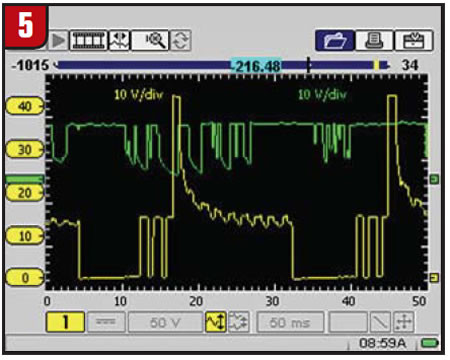
In Figure 6 the drops were large enough to make me think the valve was stuck, but the bottom of the pattern still had a rounded look that wasn’t present on a 2-1.
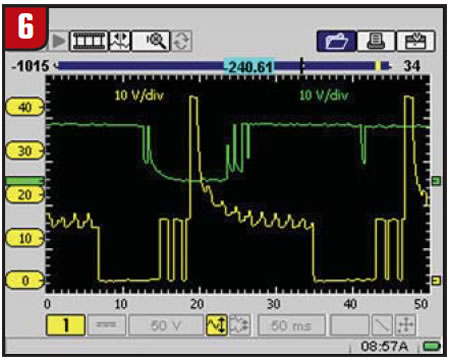
This is not just an isolated problem; it’s common industrywide. This code doesn’t seem to be as much of an issue on the 604s or 45/55RFEs. As a preventive measure, at Certified we vacuum-test the SSV on 606s and repair as needed. We have also solved this problem by replacing the valve-body and solenoid assembly. When we inspect the core valve-body and solenoid assembly we almost never find anything wrong with it, yet the replacement still fixes the concern.
At this point we replaced the valve-body and solenoid assembly. This time we got a good pattern with no glitches (Figure 7). After repair and a thorough road test, the glitches from figures 1, 2, 5 and 6 never recurred.
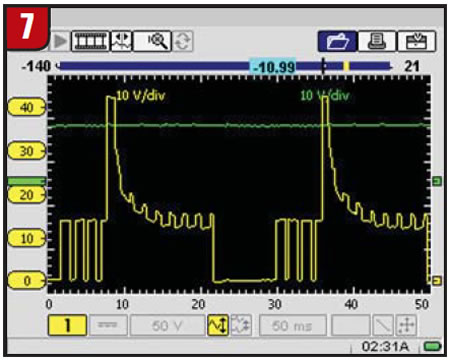
I think that if the SSV were stuck solid in the LR position, then as the TCC was commanded on the voltage on the ground side of the LRPS circuit would show a pattern similar to that of a 2-1 downshift. I never came to a conclusion as to exactly why we had the glitches on the scope pattern, but I do know that the valve-body and solenoid assembly fixed it.
Our analysis of the valve-body and solenoid assembly showed no problems. One word of caution is that the torque specs on the valve-body to valve-body bolts are super critical. If you’re building these “in house” be sure to use that torque wrench!
Intermittent problems can make for big headaches. All in all, this vehicle was driven more than 80 miles while we had it. It never once triggered the code for us.
We could have replaced the valve-body and solenoid assembly without all the scoping and driving, but we had doubt that it would fix it, since the car came in for the same problem and a different transmission had been installed. The scope really showed us what was going on and gave us confidence in the fix.
A few days later, we did a follow-up call. We confirmed that it’s fixed and the customer is happy. At the end of the day, that’s what I’m talking about!














